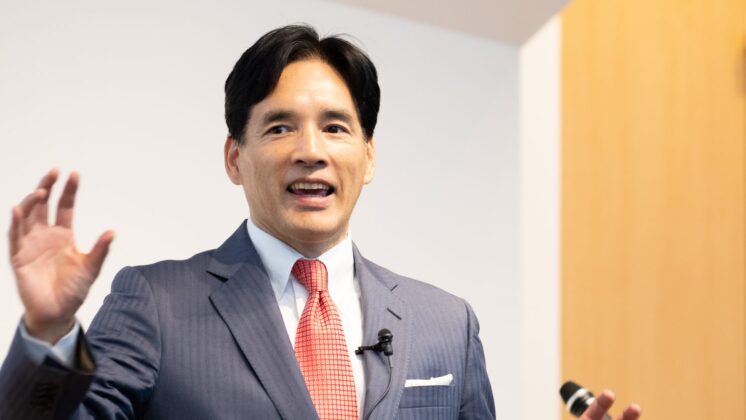(I produced this column based on my own tweets. I made minimum corrections and additions to my tweets, thinking that columns like this should communicate how I felt and what I thought at each point.)
The third day of the G1 Summit has just begun. I’m in a session titled “What Is Intelligence?” with Kenichiro Mogi and Jiro Kokuryo. Mogi and Kokuryo are creating an interesting contrast – stillness versus dynamism, cool versus hot. I flatter myself that I did a fine job in casting them. Many participants attended this session. (Click the link to view the archived video.)
We launched a program called “G1 Kids” as a new initiative this year. We have been encouraging participants to come to the G1 Summit with their family members. I bring all my family to the meeting every year. I planned this G1 Kids program, hoping to give children valuable learning opportunities by taking advantage of a conference that attracts so many intellectuals. The program will kick off at 9 a.m. today. I’m planning to visit the first period to check on it.
The first period for the G1 Kids program is a gym class. Taishin Kohiruimaki, a former K1 champion from Misawa, Aomori Prefecture, is the instructor in this class titled “Learning to Kick and Punch.” Children receive lessons from Kohiruimaki in a Japanese-style room together with four American assistants in karate uniform who attend the Kohiruimaki Dojo from the U.S. Misawa Air Base. Wearing the Kohiruimaki Dojo’s T-shirt, the bare-footed kids are getting into the lesson now.
The second period taught by Daisuke Iwase is titled “Working in the world.” Kenichiro Mogi spoke to children before the second period. Daisuke Yanasawa from KAYAC is the instructor for the third period, titled “How to Develop Games.” Kazuhiro Fujiwara takes over as the teacher in the fourth period. The fifth period after lunch is a “Field Day in the Snow.” G1 Kids is open to all children from the fifth grade up. My three oldest sons are taking part in the program.
Other breakout sessions included one on Japan’s communicative power. At this session, Shinichi Tanaka moderated discussions by Commissioner for Cultural Affairs Seiichi Kondo, Noriyuki Shikata from the Prime Minister’s Office, Akira Tsuchiya from the World Economic Forum, and Yoshikazu Kato, the best known Japanese in China. Kato, 27, is the youngest G1 Summit participant. (Click this link for the session proceedings.)
Another breakout session addressed the question of the collapse of the Euro. Hiromichi Mizuno from Coller Capital, Jesper Koll from J.P. Morgan Chase & Co., and Yuri Okina, a former Bank of Japan economist now working for The Japan Research Institute, Ltd., comprise the panel for this session. Noriyuki Yanagawa from the University of Tokyo moderated their discussions. (Click this link for the session proceedings.)
We are in the final round of breakout sessions at the G1 Summit. The session on “Integrated Tax and Social Security System Reforms” is streaming on the V-CUBE web conference system now. In addition to incumbent Senior Vice Minister of Finance Yukihisa Fujita, politician Keiichiro Asao and Hisao Endo from Gakushuin University sit on this panel which is moderated by Keio University associate professor Seki Obata. (Click this link to view the archived video. )
“China’s Rise and Japan’s Diplomatic Strategies,” is a session in this round that we kept off-limits to tweets, blog entries, and reports in other media. The Special Advisor to the Prime Minister Akihisa Nagashima, LDP politician Taro Kono and Ken Jimbo from Keio University are the panelists here. The moderator is Koji Murata from Doshisha University. It was a session I really wanted to broadcast, but I chose to keep it completely off the record in the hope of helping the panelists examine and develop concrete strategies for Japan-China relations.
Another breakout session in the final round is titled “Spreading the civic power in disaster-stricken areas – in cooperation with Project KIBOW.” Three individuals I had met through the KIBOW Project took the podium at this session. They were Kenji Suzuki from the Yoake Ichiba dining and drinking spot in Iwaki, Tomohiro Takei from MAKOTO in Sendai, and Masahiko Haga from Kirikiri in Otsuchi Town. Daigo Sato, one of the KIBOW Project’s founders, moderated their panel discussions.
Statesmen such as Minister Hosono, Governor Eikei Suzuki of Mie Prefecture, and Hiroshige Seko, are taking part in this KIBOW session. In a packed room, they are listening intently to the experiences of people affected by the 3/11 disaster. I was moved at the sight of the eminent figures listening very carefully to the words of ordinary citizens.
Haga’s words reverberated in my soul. “I didn’t survive the tsunami because of what I could do. Something intangible gave me strength and allowed me to survive.” I found his words inspiring. (Click this link for the session proceedings.)
I’m in a room for the G1 Kids program now, sitting in a seiza position at a session on “Getting to know work” organized by Kazuhiro Fujiwara. Children are studying around low dining tables in this Japanese-style room.
We’re having lunch now. The Shibata family trio gave a shamisen performance after a martial arts demonstration by Kohiruimaki. The show was fantastic.
This is the last session broadcast from the G1 Summit 2012. Governor Eikei Suzuki of Mie Prefecture, President Yoshikazu Tanaka of GREE, Inc., and alpinist Ken Noguchi sit on this panel. They are all in their 30s. The youngest prefectural governor in Japan, the youngest billionaire in Asia, and a charismatic alpinist are on the platform. The speakers of this fourth G1 Summit range widely in age from people in their 20s to those in their 80s. Many of the Summit participants are in their 40s to 50s. With respectful attention, I listened to the relatively young leaders in their 30s who served as keynote speakers.
People say “younger Japanese are so and so” whenever the opportunity arises. But I have a lot of faith in young Japanese. I have many opportunities to come in contact with them because I teach at a graduate school of management and support young venture companies. Japanese youngsters are terrific. They’re great!
The final session takes a look at “What Leaders Should Do.” This session features Shoichi Watanabe as a speaker. Unfortunately, this is another session we have chosen to keep private. I’m going to listen intently to what Watanabe has to say. (Click this link for the session proceedings.)
At the closing ceremony, I expressed our appreciation to the sponsors of the G1 Summit. Then, the G1 Summit board members shared their impressions of this fourth conference one by one, which in turn was followed by comments from participants on the floor. To conclude the G1 Summit 2012, I made three points at the end. “The time for change is now,” I said to wrap things up. “Let’s start taking actions. Let’s think and act globally. And let’s meet again at the G1 Summit next year as better individuals.”
After the closing ceremony, I picked up my bag and jacket, and hopped on a bus to Misawa Air Base. There was no time for me to say goodbye to every participant. The rest of my family were already on the bus. I spoke with other participants on our way to Misawa Air Base in what may be called a “review session”.
The people at Misawa Air Base were truly courteous. I thanked them for allowing us to visit the Base on a Sunday, giving a deep bow. The commander of the Base spoke to us in person and took us to a hanger filled with F2 and T15 fighters as a special arrangement. We have enjoyed two significant study tours this year, with the visit to the Rokkasho spent nuclear fuel reprocessing plant at the start of the summit.
From Misawa Air Base, we continued down the runway until we reached Misawa Airport. Taking advantage of a flight delay, G1 Summit participants started a dinner-cum-review session at the airport. A lively exchange ensued. GLOBIS staff members were holding a party to mark a job well done, and I’m grateful for their work. Thank you all. You were terrific.
We took off from Misawa Airport. Throughout the flight, I continued talking to a G1 member who sat next to me. I took a stroll down the aisle of the plane. All the participants and staff members were sound asleep. They must be tired, I thought.
I asked my children what they thought about the G1 Kids program on our drive home from the Haneda Airport.
I have just returned home with my family. Let me look back on the final session with Shoichi Watanabe, which I could not tweet about. The session consisted of Watanabe’s 30-minute-long speech, a 15-minute dialogue between Watanabe and myself, and a 15-minute question-and-answer session with floor participants. After that session, we had a closing session for 15 minutes.
I would like to take this opportunity to thank everyone who took part in this meeting. Thank you very much for taking part in the G1 Summit 2012. Let’s start taking actions from today as G1 Summit participants. I would also like to express my appreciation to those who followed this conference on Twitter and streaming broadcasts on the V-CUBE system. We ask for your continued support for the G1 Summit.
Thanks to Kenichiro Mogi, my children have begun spending every spare moment reading books. Their attitude changed because of what Mogi spoke at the G1 Kids program. “You must study because the world you see changes according to the height of the stack of books you have read. Doing something your brain considers troublesome is good for your brain.” I am deeply grateful to Mogi for teaching this to my children, and I hope he has more advice for my kids again next year.
February 2012
Yoshito Hori
Written on the basis of my own tweets



